Our Core Services
Take a look at the below services list and click on each one to learn more about that service.
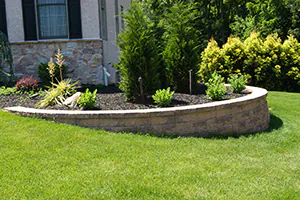
Landscaping
B. DeMichele is a leading expert in landscaping in PA, NJ, and DE. We offer all of the basics of a great landscape and then some, such as irrigation systems, custom landscaping designs, and hardscaping.
Softscaping
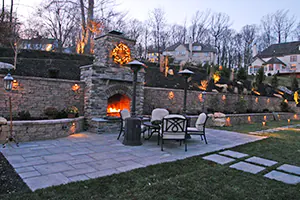
Landscape Design
A well-planned landscape design can add beauty and value to a property. During the design process, B. DeMichele will provide you with suggestions on the best types of plants and trees for our planting zone, taking into account your soil type and personal preferences.
Landscape Design
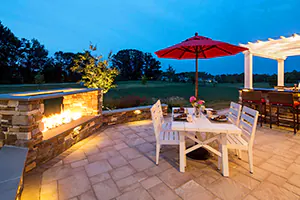
Hardscape
B. DeMichele takes pride in all of our hardscaping projects! Hardscaping can be used to create pathways, patios, and terraces. We use quality materials and installation techniques to ensure that your hardscaping looks amazing for years to come.
Hardscaping
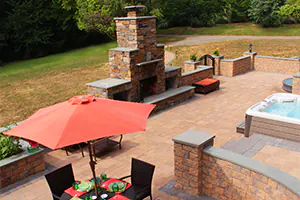
Pavers
Pavers are a great way to add a unique and attractive touch to any outdoor space. B. DeMichele can help you find the perfect paver style for your needs. Pavers can be used for a variety of landscaping and hardscaping projects.
Paving

Outdoor Living Spaces
Having an outdoor space to gather with your friends and family makes staying home a treat! With our custom designs and installations, B. DeMichele can help you create the outdoor space of your dreams.
Outdoor Living
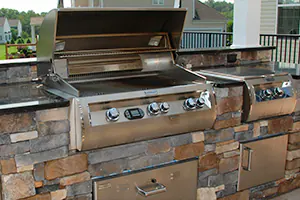
Outdoor Kitchens
Outdoor kitchens are a must for entertaining! We have many years of experience with installing outdoor kitchens, from basic islands with built-in grills to full outdoor kitchen designs.
Outdoor Kitchens
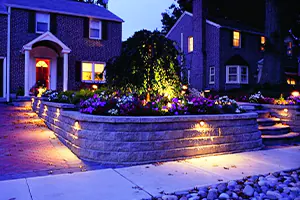
Landscape Lighting
Landscape lighting is a must! It adds a nice warm glow to your space. B. DeMichele uses only the highest quality lighting fixtures in our landscape designs. All of our light fixtures come with a 10-year warranty.
Landscape Lighting
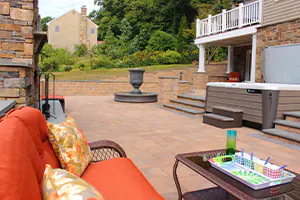
Backyard Audio Services
Take your backyard entertaining to a whole new level with backyard audio. B. DeMichele will help you to create a compelling audio experience for you and your guests - utilizing the latest outdoor audio technology.
Backyard Audio

Outdoor Walkways
B. DeMichele offers a wide range of options for your walkway design, such as pavers, stone or concrete. We will work with you on the design and come up with the appropriate materials and design to meet your specific needs.
Outdoor Walkways
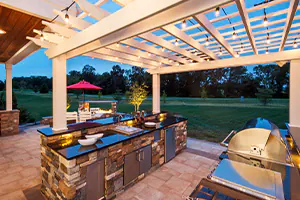
Pergolas & Gazebos
Pergolas and gazebos are a great way to add some shade to beat the summer heat! B. DeMichele has many options when it comes to creating your perfect covered patio area.
Pergolas & Gazebos
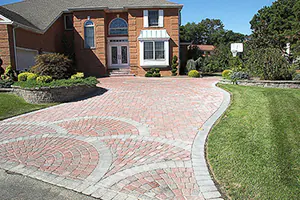
Driveway Paving
Many homeowners choose to migrate away from traditional asphalt and concrete driveways and instead opt for pavers. B. DeMichele will work with you on layout, pattern and design to make your driveway a real focal point of your exterior!
Driveway Paving
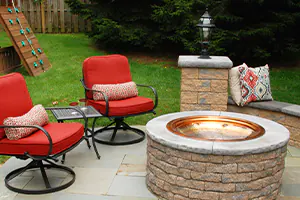
Outdoor Fireplace & Firepits
Outdoor fire pits and fireplaces are a great addition to any outdoor living space. They provide a cozy ambiance for outdoor gatherings. With a variety of styles and designs, we can design the perfect outdoor fire pit or fireplace to fit your individual needs.
Fireplace & Firepits
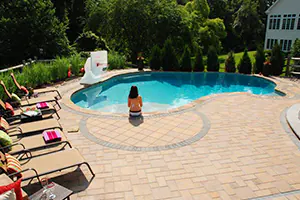
Pool & Spa Hardscape Installation
From pools to outdoor spas, B. DeMichele offers a wide range of hardscape options to fit your budget and lifestyle. Our experienced technicians will help guide you through the entire process, from the initial consultation to the installation of your hardscape patio surrounding your pool or spa.
Pool Hardscaping
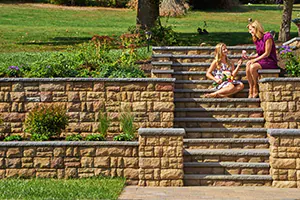
Retaining Walls
Retaining walls provide many benefits. Our trained professionals will assess your area to determine the size, shape, and materials needed for your particular wall.
Retaining Walls
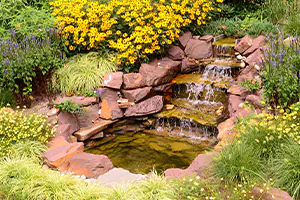
Water Features
Our expertly designed ponds and waterfalls will add a creative touch to your outdoor space. We also install many other types of water features, such as fountains and contemporary water effects.
Water Features
Testimonials Get Started
Landscape Design Process
Our design process begins with a free on-site meeting with one of our expert landscape designers. We service the tri-state area from our office in Media, PA and will send someone out for this on-site visit. During this initial meeting, our designer will review with you your property and evaluate your objectives, budget, and site conditions. After the initial meeting, a design proposal is developed and we determine if the project will benefit from a drawn landscape plan. If so, a design fee is required for a drawing to cover some of our expenses incurred during the design process but is kept minimal due to our goal of installing the final plan.
Upon approval of the design proposal, our designers will assess the scope of the project. We will then visit your property to obtain site information such as the locations of existing structures, plantings, and other features to create a base plan which will serve as the basis of your design. At this point, the designer will begin the design process of conceptual drawings and details to creatively meet your landscape requirements. The concepts will show potential planting beds, plantings, hardscape features such as patios and walls as well as any other more detailed items. While reviewing the concepts, we work to combine your preferences in a more detailed plan within your budget. When the plan and preliminary pricing are approved we create a final plan with a proposal for installation.
The final stage of the design process is to produce working drawings. These drawings may include elevations or details that will aid in the construction of design elements such as fire pits, retaining walls, or outdoor kitchens. From these drawings, your outdoor space can be constructed accurately and professionally as envisioned by you and your designer.
Reach Out Today
Get Your Dream Backyard Oasis
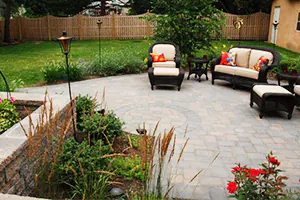 You don’t have to live on an estate to enjoy an estate-worthy landscape. Imagine gazing upon an artistic waterscape from your back door; the soothing sounds of the waterfall make every day a Zen experience. In the evening, maybe you’ll do some informal entertaining on a multi-level deck surrounded by lush plantings. As the sun goes down, your guests may gather lazily around a Tuscan-style firepit that is accented with just the right amount of mood lighting. If you can dream it, your landscape designer can create it. No matter how large or small your property, an innovative, artistic landscape with the “wow” factor is within your grasp.
You don’t have to live on an estate to enjoy an estate-worthy landscape. Imagine gazing upon an artistic waterscape from your back door; the soothing sounds of the waterfall make every day a Zen experience. In the evening, maybe you’ll do some informal entertaining on a multi-level deck surrounded by lush plantings. As the sun goes down, your guests may gather lazily around a Tuscan-style firepit that is accented with just the right amount of mood lighting. If you can dream it, your landscape designer can create it. No matter how large or small your property, an innovative, artistic landscape with the “wow” factor is within your grasp.
As homeowners strive to create exteriors that function as true outdoor rooms, the concept of landscaping has evolved into a bonafide art form. Combining hardscaping elements with meticulously chosen plantings, today’s experienced landscape designers can customize a comprehensive design plan that accentuates the natural splendor of your grounds while increasing its visual, functional, and environmental appeal. Experts can construct a dynamic new scene from the ground up, or easily incorporate fresh and exciting new details into any existing layout.
The success of your project, whatever the scale, pivots on the design/build team you select. Keep in mind that while many call themselves design/build, few have the credentials to back up the title. Be sure to consider whether the firm is a member of the exclusive EP Henry Authorized Landscaping™ Contractor Program. These contractors are pre-screened professionals who are monitored regularly by EP Henry to ensure their work is of the highest quality.
Your design/build firm should also have Interlocking Concrete Pavement Institution (ICPI) certification. Members of ICPI have access to a shared wealth of resources that provide customers with the most current information and techniques available, including landscape-imaging software, technology that allows you to see the finished model before construction even starts. Consistent, proper construction practices are crucial in designing hardscapes and landscapes that last forever.
With both ICPI certification and membership in the EP Henry Authorized Landscaping™ Contractor Program, B. DeMichele, Inc. of Media PA has both the vision and expertise to build a cohesive plan that is in harmony with your lifestyle, your property, and your wallet. B. DeMichele is a full-service residential landscape contractor; an all-inclusive design/build firm capable of overseeing and executing all aspects of your project. We specialize in ground-breaking design and installation of hardscaping, landscaping, and nightscaping as well as waterscapes and irrigation.
So, whether it’s managing a completely new design project or simply assisting with an existing job, from original plans to a finished design, DeMichele can create a distinctive backdrop that will enhance your property value and your lifestyle. Our experienced professionals have the right tools and credentials to improve upon the natural appeal of the existing surroundings. For more information, please contact Blasé DeMichele at 610-361-7832 or visit www.DeMicheleinc.com and start planning your backyard resort.
Get In Touch